Hockey is, literally speaking, no more than just a game. But as with any sport, it means so much more to those that follow it. The emotional ride of the NHL can offer nearly boundless satisfaction just as easily as persistent gloom. Fans and players alike revel in the electricity of every win and stew in the irritation of every loss, always believing there is some chance of winning the Stanley Cup…until there isn’t.
The Chicago Blackhawks have taken things full circle in recent history. From 2004 to 2015, a span of 11 years, the organization metamorphosed from an outright embarrassment into a near dynasty. In the past four years, they’ve struggled to maintain that dominance. Can they reach the promised land once again? Before we attempt to answer that question, let’s take a look at the evolution.
Rock Bottom: Blackhawks Named Worst Franchise In Professional Sports
In February of 2004, an ESPN report ranked the Blackhawks as the single worst franchise in North American sports. At the time, Chicago was in the midst of an absolutely ghastly season in which the team would eventually compile only 20 wins and 59 points in 82 games.
But a bad team with a terrible record was simply the culmination of numerous colossal issues plaguing the organization. These problems reached their critical mass (embodied in the form of the ESPN report), and constituted the lowest point of the darkest period in Blackhawks’ history.
So what were these issues, exactly? One doesn’t have to look much farther than Blackhawks’ owner at the time, Bill Wirtz.
Wirtz the Penny-Pincher
Wirtz, unceremoniously nicknamed “Dollar Bill” by fans due to his stingy nature in hockey-related matters, was arguably the single largest contributor to the Blackhawks’ slide into utter irrelevance. Wirtz’s frugality was a constant across his 41 years of presiding over the organization, and was the chief reason behind the steady defection of Blackhawks’ players during the 1970s, 80s, and 90s. In this letter to season ticket holders, Wirtz publicly criticizes Blackhawks’ star player Bobby Hull about signing for more money with the World Hockey League.
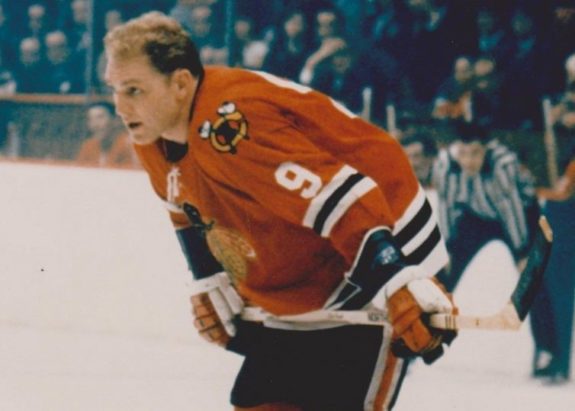
In the aforementioned 2004 season, the average payroll among NHL teams was $44,400,490, but the Blackhawks clocked in at a comparatively minuscule $30,867,502.
Related – 50 Years Ago in Hockey: FINALLY! Bobby Hull Breaks the Record!!
Wirtz Blocking Broadcasts
Wirtz is perhaps most infamous for his seemingly archaic refusal to allow local broadcasts of Blackhawks’ home games. His reasoning, as told by Chicago Bulls and White Sox owner Jerry Reinsdorf, “Wirtz truly believed that it was unfair to the season ticket-holders to give away the home games on TV for free.” (from Chicago Tribune, Sept. 27, 2007) Put differently, the Blackhawks’ owner thought televising home games was an insult to fans who consistently paid to attend them live.
There was speculation that Wirtz may have also believed making home games unavailable on television would increase live attendance, a consideration that – if actually held – drastically contradicted the Blackhawks’ floundering attendance numbers in the early 2000s.
This was likely the most destructive of Wirtz’s policies, as it concurrently severely limited the Blackhawks’ exposure in the written and electronic media and alienated current and potential fans.
Record-Low Game Attendance
As established, the Blackhawks’ popularity was in a major decline during the dreadful 2003-04 season. At year’s end, the average home attendance figure was 13,253 – the franchise’s lowest in more than two decades. Around this time, it was estimated that there were only 5,000 season ticket holders, and the Chicago Tribune no longer bothered to assign a beat writer to Blackhawks’ road games.
A home game against the Florida Panthers on Feb. 29, 2004 drew less fans than a Chicago Wolves (AHL) home game that same night. The prevailing attitude towards the team was one of apathy, having moved on from despondence and acrimony. Among team supporters, the Wirtz name had been synonymous with melancholy for years, but it lost even this undesirable sentiment as Chicago hockey fandom continued to wither away. People no longer cared.
Wirtz Brings out the Worst
Wirtz is widely regarded as the second worst owner in hockey history behind only the disreputable Harold Ballard. His combination of penny-pinching and willing determent of local Blackhawks’ coverage elicited an unparalleled vitriol in the team’s fans, culminating in fans booing throughout his pre-game memorial following his death in 2007. It was one of the most distasteful moments in Chicago sports history.
If Chicago’s downward spiral of the early 2000s was a precipitous freefall, then the 2003-04 season was the calamitous crash. The franchise was in ruins, never having been less successful on the ice or less popular off it.
Blackhawks’ Gradual Escape From the NHL Cellar
While the franchise made far more blunders than good moves during the aforementioned freefall, a few positive events were actually put into motion before the miserable 2003-04 campaign. While they did not make an immediate difference, two organizational moves — draft picks to be precise — stand out as rather brilliant in retrospect.
The Selection of Two Elite Defensemen
First came Duncan Keith, a defenseman drafted at 54th overall in 2002. Fans had to be patient; his first NHL game occurred more than three years after he was drafted (2005-06 season). His previously latent ability finally emerged in the 2007-08 season, where he recorded 12 goals and 20 assists for 32 points. Keith was the first player of what we still today consider the Blackhawks’ core.
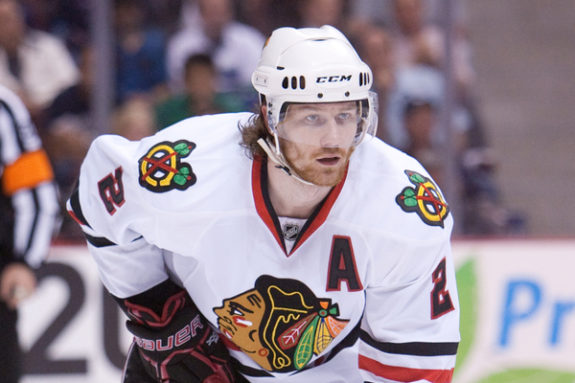
Next came Brent Seabrook, taken 14th overall in the 2003 NHL Draft. Seabrook was one of many great players selected in what was arguably the best draft in league history. Like Keith, he played his first NHL game in the 2005-06 season.
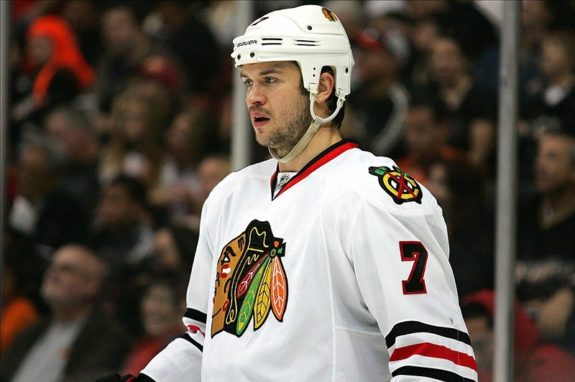
Seabrook’s rookie season was extremely promising, as he amassed 32 points in just 69 games and somewhat miraculously managed to be a +5 on a Blackhawks’ team that ended the year with a hideous -74 goal differential.
With two eventual franchise cornerstones banked, the Blackhawks nevertheless still had plenty of work left to do.
Seeds of Change
In the summer of 2005, more positive steps were taken by Blackhawks management, truly a rare sight at the time for an organization that had constantly been getting in its own way for years.
They started by hiring Dale Tallon to serve as general manager. Tallon is often berated by today’s Blackhawks’ fans for being a little too extravagant with the organizational checkbook (rightly so, perhaps, but a problem Blackhawks fans are grateful to even have had!) and did not draft well with Chicago aside from two lottery picks (more on this below). Notwithstanding the negatives, we will see that Tallon had an emphatically positive role in the franchise’s resurgence.
To start his tenure with the Hawks, Tallon dipped into the free agency market and acquired goaltender Nikolai Khabibulin and defenseman Adrian Aucoin in the 2005 offseason.
Chicago signed Khabibulin to a monstrous four-year, $27 million contract, making him the highest paid goaltender in the NHL. Coming off a Stanley Cup win and having a reputation as one of the league’s best goaltenders, Khabibulin was the highest-profile free agent signed by the Blackhawks in as many years as anyone could remember.
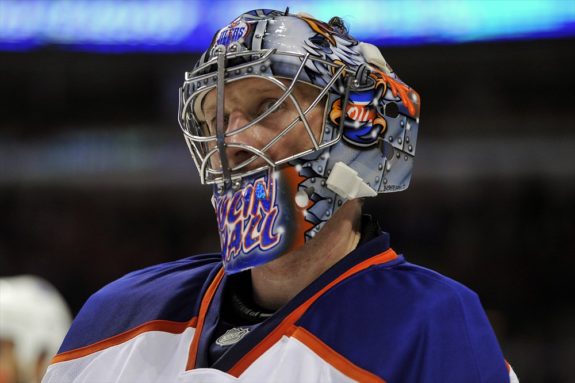
Khabibulin was the biggest name to come to Chicago that summer, but the Blackhawks also agreed to terms that offseason with one of free agency’s better defensemen in Aucoin, who was signed to a four-year, $16 million contract. Aucoin and Khabibulin exemplified the apparent newfound willingness of Wirtz (with Tallon’s influence) to genuinely invest in the Blackhawks.
In Dec. 2005, Tallon traded Matt Ellison (who played seven total NHL games after the trade) and a third round pick for a young and struggling player named Patrick Sharp.
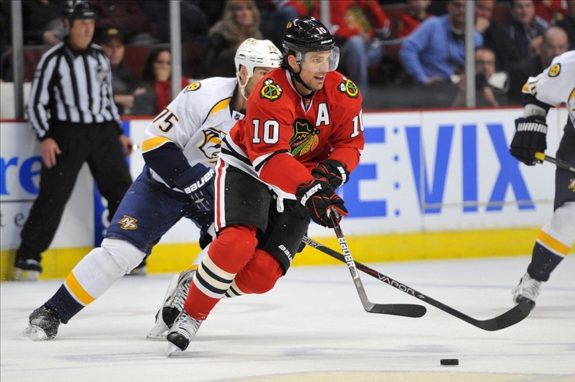
Sharp would go on to play a fairly unremarkable 50 games with Chicago in the 2005-06 season. His importance to Chicago’s revival would not be immediately apparent, but we all know he was eventually an integral part of three Stanley Cup wins. Ah, but I get ahead of myself.
The season itself was another dud, as the Blackhawks finished 26-43-13 for 65 points. Because of this, the organization would be picking early in the NHL’s 2006 NHL Draft, third overall.
Introducing the New Faces of the Blackhawks’ Franchise
Enter Jonathan Toews, drafted third overall in 2006, but viewed today as the consensus first overall pick in his draft if it were to be re-done. Projected as a safe bet to become a high-echelon No. 1 center, Toews was Chicago’s most talented prospect in many years.
Toews and the Blackhawks mutually agreed he should remain at the University of North Dakota for another year to continue augmenting his game. Chicago fans would have to wait to see their future captain in NHL action.
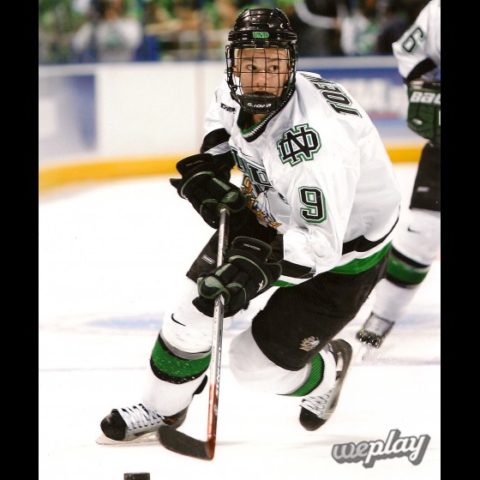
The 2006-07 season didn’t bring much more hope, as the Hawks went 31-42-9, for 71 points. Ending the year as the NHL’s fifth-worst team, they had an 8.1% chance to win the draft lottery and obtain the first overall pick. Which they did. The rest, as they say, is history.
We all know by now the Blackhawks used their pick to draft Patrick Kane, who went on to become the second face of the franchise alongside Toews.
The 2007 offseason was all about prospects camp. The two new young prospects both looked outstanding and were expected to make the Blackhawks’ roster. There was a unfamiliar but distinct optimism in the air. For the first time in many years, Chicago hockey appeared primed to be exciting again.
And Toews and Kane did not disappoint.
Toews began his career by registering at least a point in each of his first 10 games, the second-longest such streak in NHL history. He ended the season 2007-08 season with 24 goals and 30 assists for 54 points.
Related – Jonathoan Toews Bio: Beyond the Glory
Kane, meanwhile, didn’t start off quite as hot as Toews, but his offensive skills impressed. His vision and puck handling were clearly second to none. He ended up with 21 goals and 51 assists for 72 points, earning him the Calder Trophy for rookie of the year. Toews was the runner-up.
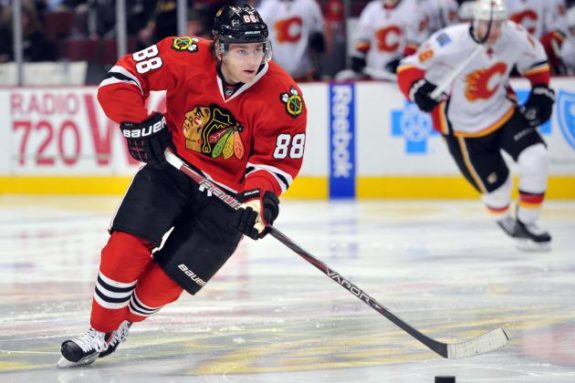
The Blackhawks would go on to miss the 2007-08 playoffs by a few points, but by this time the fans hardly minded.
Blackhawks Management & Policy Changes
Meanwhile, on the management front, the elder Wirtz succumbed to cancer on September 26th, 2007, passing ownership of the team onto his son Peter. For reasons unknown, Peter immediately handed the reigns over to his brother, William Rockwell “Rocky” Wirtz. It is difficult to predict where Peter might have taken the franchise, but Rocky has been the equivalent of a godsend for the Blackhawks organization.
Related – The Breakaway: Wirtz Family Cups & Controversy
Early in the 2007-08 season, Rocky hired well-known marketing savant John McDonough to serve as the team’s president. The two had a common goal; bring winning hockey back to Chicago. Their first order of business was to get a handful of the Blackhawks’ home games on television. And on top of that, stadium attendance numbers spiked as well. There was a burgeoning interest among Chicagoans in the flashy, lively young team with the new owner and team president.
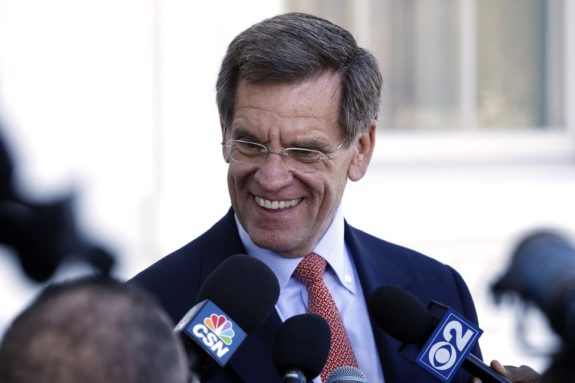
But the changes didn’t stop there. The organization made the difficult decision to fire long-time Blackhawk but short-term head coach Denis Savard just four games into the 2008-09 season. He was replaced with the more experienced Joel Quenneville, who has since become the second- winningest coach in the NHL.
In July of 2009, Tallon made one of his most important free agent signings when he brought Marian Hossa into the fold. In hindsight, the dominant two-way power forward might have been the final piece to the puzzle on the ice. But Tallon was never given the chance to see his work come to fruition. He was replaced by Stan Bowman as general manager just a few weeks later.
Great Leap Forward: Blackhawks Revival Comes Full Circle
The Blackhawks had come a long way since the bottom of the barrel in 2004. Just six years later in 2010, they hoisted the Stanley Cup after this famous goal.
The franchise’s first championship since 1961 induced a summer-long party in Chicago; the once-dying Blackhawks now the pride of the city. A team that previously had difficulty filling half the stadium now played in front of crowds that made setting attendance records a matter of blasé routine.
In the 2013 season, Chicago played half of the lockout-shortened season without losing a game in regulation. In the spring and summer, the Blackhawks once again took their fans on the ultimate playoff ride.
To recap, Seabrook’s overtime goal ended an emotional Game 7 and completed a series comeback against the Detroit Red Wings. Kane sent the Blackhawks to the Cup Final with another playoff hat trick against the LA Kings. And, of course there was 17 seconds to win it all from the Boston Bruins.
But wait; there’s more! After losing a devastating Game 7 to the Kings in the 2013-14 Conference Finals, the Blackhawks added to the dynasty profile with another championship in 2015. This time they won that Conference Final series in Game 7 against the Anaheim Ducks, and beat the Tampa Bay Lightning four games to two in the Final.
Remember that guy who was drafted and started all this in 2002? Yeah, well he was pretty integral in the win.
Where Are The Blackhawks Now?
While all this reminiscing has been fun, it’s time for a dose of reality. As much as we’d like to live in the past, the 2010, 2013, and 2015 championship wins are long gone now. Since then, the Blackhawks have either lost in the first round of the playoffs, or not even made it in.
We all know it’s extremely difficult to win a Stanley Cup, let alone three in six years. The Blackhawks could possibly never win again. While that would be disappointing, the organization and fan base still has something pretty special to hang their hats on.
Or, they could stage another revival. The Blackhawks have recently signed on a young, aggressive head coach named Jeremy Colliton. While great players like Sharp and Hossa have retired, Keith, Seabrook, Toews and Kane remain. Could they be mentors for the exciting young talent Bowman has slowly but surely been acquiring?
In the 2019 NHL Draft the Blackhawks once again picked third overall as they did in 2006 when they acquired Toews. This time around they chose another center, Kirby Dach. Experts are excited about Dach’s potential. He could prove to be another game-changer.
So what will it be? Will the Blackhawks revert back to irrelevance? Or is the dynasty set to continue? I guess we’ll all just have to wait and see how history unfolds.
*Originally written by Sean Sarcu in Jan. 2014